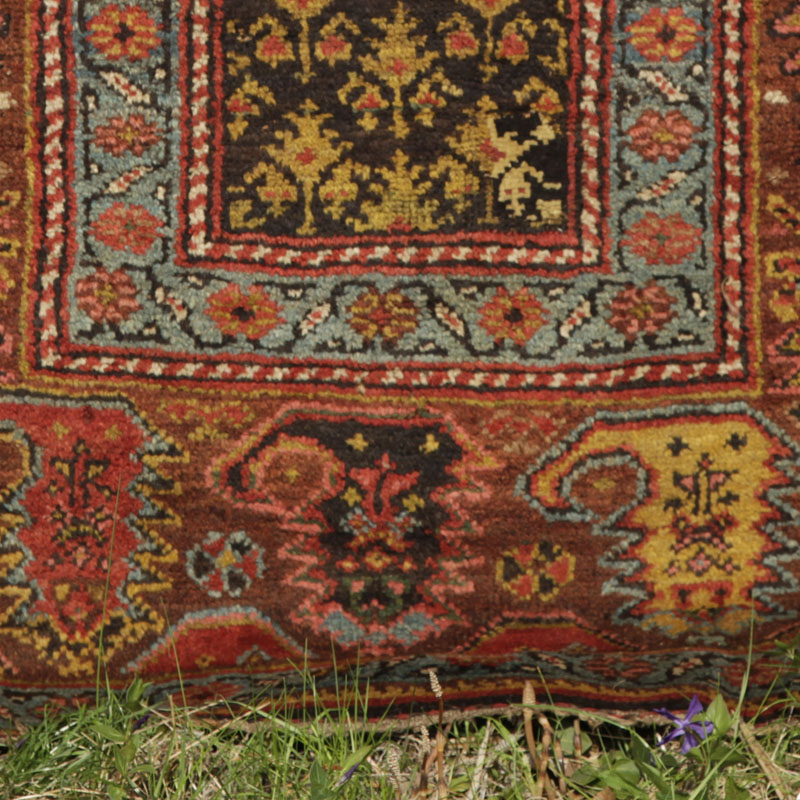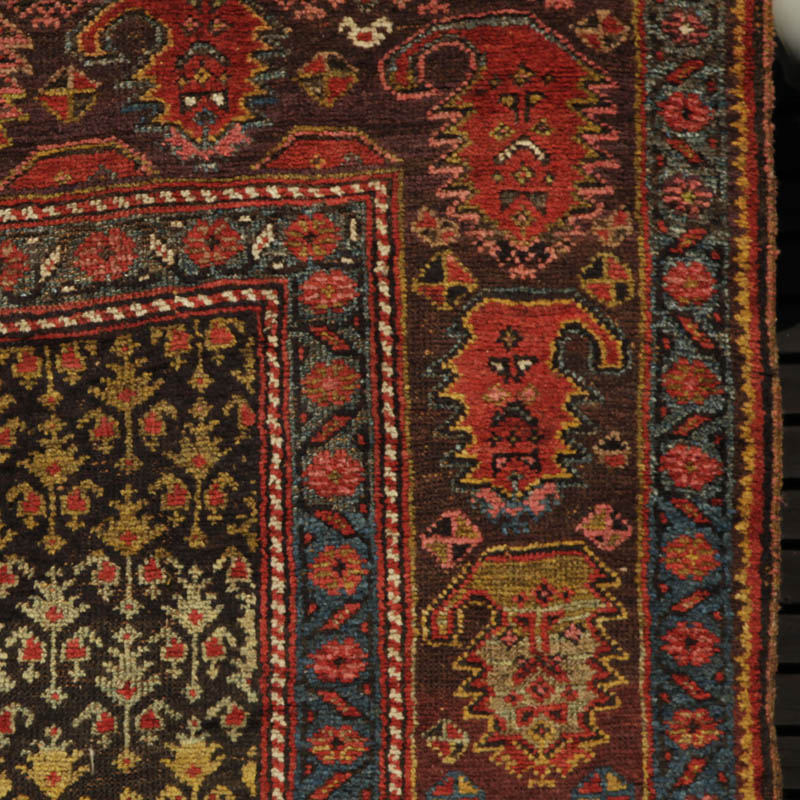Click on image to view in larger size.
See image in extra large size (opens jpg in same window) (2.3 MB).

North-West Persian, Kurdish. As always, difficult to pin down. Designwise it's more a village rug because of the city-influenced design. The excellent strong, all organic dyes point to an age of 100-120 years.
What is impressive is the wide border with its bold, rustic botehs in red, yellow, green and black, set off the aubergine-to-brown ground by triple outlines. The botehs seem to carry a (sulky) face. I know it's not meant to be a face but rather floral elements, but I can't help seeing these faces.
Interestingly, the botehs at the bottom of the rug start in the manner of an all-over repeat, all pointing to the left, and including the only black boteh in the entire rug. Then, the weaver must have changed her mind and inserted the narrow field, using just one large boteh with alternating directons further on in the main border, which necessitated a restart and a repositioning of the botehs along the central vertical axis of the main border. Why she started with the first couple of botehs with the top half instead of putting in whole ones will remain a mystery.
The dividing barber pole line with diagional arms extending at both ends only occurs after the first couple of botehs in the vertical main border, and is then given up. Further up, small quartered diamonds, palm leaves, winged devices (I can't help seeing rabbits) and small dots are used to enliven the space around the large botehs.
Towards the top, the idea of an endless boteh repeat seems to recur – it's unclear wether the bits of hexagons that appear behind the field (we also see them at the very bottom of the rug) are meant to be the top of botehs further down in a repeat pattern; they are similar enough with their triple outlines, but do not quite match the top end of the botehs proper.
The narrow field is hardly wider than the main border and filled with a greenish yellow repeat palm leaf pattern on black ground. Could be based on a Persian textile pattern, I have not yet found close matches in other rugs (but still searching). The small palm leaf motifs (which have some pleasing internal variation regarding their length and the red dots they carry) are flanked by small botehs. Abrash towards a light green occurs in the upper portion of the field.
The dominant main border is flanked on both sides by blue-ground, typically Kurdish, blossom meander secondary borders showing an nice abrash of the blue, from a lighter shade to medium blue and slightly lightening up again towards the top.
The rug measures 258 x 131 cm (8ft.5in. x 4ft.3in.) The width is slightly (2 inches) less towards the middle (ca. 127 cm). Flat and very coarse construction (no warp depression), thick, tan, tightly spun wool warps, z-spun, s-plied, thick double medium brown wool wefts, and thick pile yarn (symmetric knots). The knot count is h.18/10cm x v.22/10cm, which equals 386 knots/dm2 (translated to knots per square inch, this is roughly h.5 x v.6, ie., a very low knot count of ca. 30 kpsi (have I ever handled a more coarsely woven rug?). The selvedge consists of four warps wrapped in red wool. Ends have remnants of flatwoven skirts with a simple decoration line in alternating colours (green/brown and red/brown). Soft and meaty handle. Good and even construction, no bends or bubbles, the rug lies flat on the floor.
The palette is perhaps the most unusual trait of this rug. Especially nice is the use of the aubergine in the background of the main border, the ample use of a strong, slightly greenish orange-yellow, and the way colours are combined of triple outlines around the botehs (notable is a light madder pink). There is plenty of saturated madder, and a brown based on madder (perhaps over-dyed brown wool?) in the main border ground, an abrash from the aubergine. There is a tiny bit of darker green in the black boteh at the bottom, but the weaver seems to have run out of this colour. Black or a blackish brown dominate the ground of the narrow field . Then there a bit of good medium to light indigo blue in the secondary border and in some of the outlining. White is used sparingly in some of the minor elements (the 'rabbit heads').
Mostly good to very good pile, longer towards the sides and lower in the field; here, in some areas the pile is lower and the brown ground shines through. Some repiling in the lower right corner of the narrow field and a very small area of repiling a bit further up centrally in the field. There is some corner rounding bottom right and top left. The selvedges are a bit threadbare and loose in a part on the left, could do with conscious rewrapping. The kilim ends are a bit unravelling in parts, need securing.
All photos are taken outdoors in frontal sunlight.
















